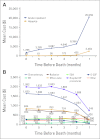Health care costs for patients with cancer at the end of life
- PMID: 23598848
- PMCID: PMC3500487
- DOI: 10.1200/JOP.2011.000469
Health care costs for patients with cancer at the end of life
Abstract
Purpose: With rising health care costs in the United States, clearly defined end-of-life (EOL) cancer costs are needed to help health administrators proactively manage this important care. Our objective was to examine EOL health care resource costs among oncology patients in a US commercial insurance population.
Methods: A retrospective claims database affiliated with OptumInsight was analyzed. Included patients had: a medical claim with cancer diagnosis between July 1, 2002, and December 31, 2009; death on or before December 31, 2009; continuous enrollment with medical/pharmacy benefits from diagnosis until death; ≥ 180 follow-up days; and active cancer in the last 6 months before death (MBD). Death was captured from facility discharge codes or Social Security Administration death files. Costs were determined by summing paid amounts on all services utilized within the last 6 MBD: cancer-related inpatient (IP) stays, cancer- related hospice care, and cancer-related outpatient (OP) services (ie, chemotherapy, erythropoiesis-stimulating agents, granulocyte colony-stimulating factors, radiation, cancer-related office or emergency room visits, cancer-related hospital OP procedures, and other services with cancer diagnosis).
Results: A total of 28,530 patients met inclusion criteria. Mean total cancer-related costs in the last 6 MBD were $74,212 (standard deviation, $112,740), comprising IP costs of $40,702 (55%), OP costs of $30,254 (41%), and hospice costs of $3,256 (4%). OP costs decreased from $6,021 in the sixth MBD to $2,238 in the last MBD, whereas IP care costs increased from $1,785 to $20,559. Hospice utilization increased from 0.7% in the sixth MBD to 35.6% in the last MBD.
Conclusion: Oncology costs increase in the last 6 MBD largely because of increased IP costs, whereas OP costs decrease.
Figures
References
-
- Centers for Disease Control and Prevention. Leading causes of death. www.cdc.gov/nchs/fastats/lcod.htm.
-
- Yabroff KR, Lamont EB, Mariotto A, et al. Cost of care for elderly cancer patients in the United States. J Natl Cancer Inst. 2008;100:630–641. - PubMed
-
- National Cancer Institute. Cancer trends progress report: 2009/2010 update. http://progressreport.cancer.gov.
MeSH terms
LinkOut - more resources
Full Text Sources
Miscellaneous


